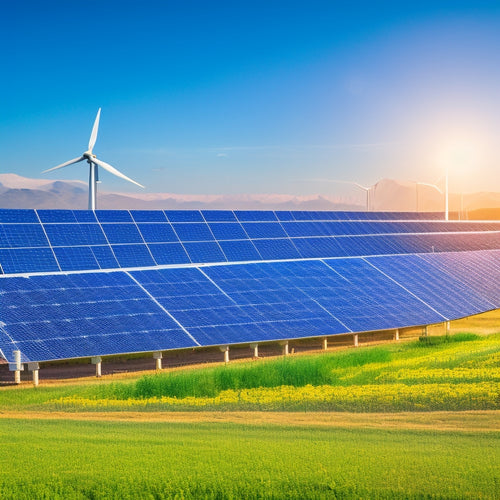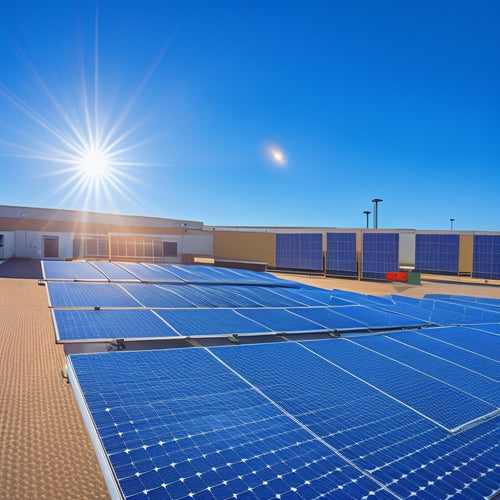
Solar Panel Rack
Share
When choosing a solar panel rack, you're not just mounting panels - you're optimizing roof space efficiency and energy output. To maximize energy production, you'll want to take into account adjustable tilt angles based on your location's latitude and seasonal sun position. Don't forget to assess the load capacity ratings to guarantee your system can support panel weight and components. Using corrosion-resistant aluminum alloy can protect against environmental factors like saltwater and high winds. By taking these factors into account, you'll be on your way to a reliable and efficient renewable energy system - and there's more to investigate to make sure you get the most out of your solar panel rack.
The Essentials
- Optimize solar panel rack placement to minimize gaps, ensure accurate alignment, and maximize energy output.
- Adjustable tilt angles are crucial for maximizing energy yield, considering location latitude, and adapting to seasonal solar paths.
- Load capacity evaluation and structural integrity are essential for secure setup, durability, and environmental factor consideration.
- Material selection should prioritize corrosion-resistant aluminum alloy for coastal environments and sustainable practices.
- Accurate site assessment and shading issue mitigation are necessary for optimal energy output and reduced grid reliance.
Maximizes Roof Space Efficiency
When designing a solar panel rack, you'll want to maximize roof space efficiency by optimizing panel placement. This involves strategically arranging panels to minimize gaps and guarantee each unit operates at peak performance.
Proper panel alignment is vital, as improper panel alignment can lead to reduced energy output. By confirming accurate panel alignment and secure fixtures, you can distribute weight evenly and minimize stress on the system.
Optimal Panel Placement
Ideal panel placement is vital to maximizing roof space efficiency, as it directly impacts the overall energy output of your solar panel system.
When planning your solar panel installation, you need to take into account the best panel orientation to guarantee maximum energy harvest. In the northern hemisphere, a south-facing orientation is ideal, as it receives the most direct sunlight throughout the day. However, you may need to adjust this orientation based on your roof's design and surrounding obstacles.
With professional panel installations, you can utilize renewable energy and reduce your reliance on the grid Energy Efficiency.
Conducting a thorough site assessment is essential to identify areas that may be affected by shade, which can greatly reduce your system's energy output. This analysis takes into account the time of day, season, and surrounding objects such as trees, buildings, or chimneys.
By identifying potential shading issues, you can strategically place your panels to minimize their impact.
Increased Energy Harvesting
By strategically positioning your solar panels, you can greatly increase energy capture, thereby maximizing roof space efficiency. This optimized placement enables you to generate more electricity from the same surface area, making the most of your investment in solar technology.
With integrated solar solutions, such as All in One Solar Power Systems, you can simplify the shift to renewable energy and guarantee a steady power supply even when the grid is down. With increased energy capture, you can reduce your reliance on the grid, enjoying greater energy independence and a lower environmental impact.
Furthermore, by leveraging renewable resources, you can take advantage of financial incentives and government policies that support sustainable energy solutions. When you maximize roof space efficiency, you also reduce installation costs and maintenance requirements, making solar energy a more viable option for your home or business.
Increased Energy Output
You can increase energy output by maximizing panel exposure to direct sunlight. This is achieved by positioning the solar panels at ideal tilt angles, which vary based on your location and the time of year.
To guarantee efficient DC to AC conversion, it's essential to pair your solar panel system with a compatible grid tie inverter that can handle the maximum power output.
Maximize Panel Exposure
Maximizing panel exposure is vital to increase energy output from your solar panel system. You want to guarantee your panels are positioned to capture as much sunlight as possible. To do this, you'll need to take into account panel orientation.
Ideally, your panels should face directly at the sun, which means a south-facing orientation is usually best. However, if this isn't possible, a west- or east-facing orientation can still produce decent results.
Proper shadow management is also essential. You'll need to assess your surroundings to identify potential sources of shade, such as trees, buildings, or other obstructions.
By understanding how shadows will fall on your panels throughout the day, you can strategically position them to minimize energy loss. Additionally, think about using a tracking system to adjust your panels' angle and orientation in real-time, guaranteeing peak energy production.
Optimal Tilt Angles
Solar panels' tilt angles greatly impact their energy output. You want to guarantee you're getting the most out of your solar panel system, and adjusting the tilt angle is essential.
The ideal tilt angle varies depending on your location and the time of year. During summer, a lower tilt angle allows for more efficient energy production, as the sun is higher in the sky. In winter, a steeper tilt angle is more effective, as the sun is lower.
To determine the best tilt angle, you need to take into account the latitude of your location and the amount of solar radiation your area receives. A general rule of thumb is to set the tilt angle equal to your latitude, but this can vary depending on the specifics of your location.
You can use online tools or consult with a professional to determine the most suitable tilt angle for your solar panel system. Accurate angle measurement is key, as even a slight deviation can result in significant energy loss.
Adjustable Tilt Angles Matter
You can maximize your solar panel rack's energy output by adjusting the tilt angle to optimize energy harvesting.
Since the sun's position changes throughout the year, seasonal angle adjustments are essential to guarantee you're getting the most out of your system, especially when it comes to renewable energy solutions and reducing your carbon footprint.
Optimal Energy Harvesting
Suboptimal Energy Harvesting
Energy yield from photovoltaic systems largely depends on the angle at which sunlight hits the panels. You can maximize energy output by adjusting the tilt angle of your solar panel rack to enhance energy harvesting. This is especially important for those who want to make the most of their solar technology investment and reduce their environmental impact.
| Tilt Angle | Energy Yield | Seasonal Adjustments |
|---|---|---|
| 25° | 95% | Summer: 20°, Winter: 30° |
| 30° | 98% | Summer: 25°, Winter: 35° |
| 35° | 102% | Summer: 30°, Winter: 40° |
| 40° | 105% | Summer: 35°, Winter: 45° |
| 45° | 108% | Summer: 40°, Winter: 50° |
Seasonal Angle Adjustments
As energy yield fluctuations become more pronounced with changing seasons, it's clear that a static tilt angle won't suffice.
You need a solar panel rack that allows for seasonal angle adjustments to optimize energy harvesting. By doing so, you'll guarantee your solar panels operate at their maximum potential throughout the year.
In the winter, when the sun is lower in the sky, you can adjust the tilt angle to a steeper position, typically between 40° to 50°, to capture more energy.
Conversely, during the summer, when the sun is higher, a shallower tilt angle of around 20° to 30° is more suitable.
This flexibility enables you to adapt to the changing solar path and maximize your energy yield.
Consider Load Capacity Ratings
When you're selecting a solar panel rack, you'll need to evaluate the load capacity ratings to guarantee the system can handle the weight of the panels, mounting hardware, and other components.
For instance, a complete panel mounting system should provide a secure and efficient setup, allowing you to maximize solar energy with durable and adjustable racks.
You'll need to calculate the total weight of the system, considering factors like panel size, frame type, and climate zone. By doing so, you can determine the maximum weight limit the rack can safely support without compromising its structural integrity.
Load Calculations Matter
Load calculations are crucial to getting your solar panel rack installation right, and it's imperative you nail them down before moving forward. You can't afford to gloss over this critical step, as it directly impacts the structural integrity of your entire system. Inaccurate load calculations can lead to a compromised system that fails to meet safety regulations, putting people and property at risk.
You need to evaluate various factors, including the weight of the solar panels, the rack itself, and any additional components. You must also account for environmental factors like wind, snow, and seismic activity, which can exert significant pressure on your system.
By conducting thorough load calculations, you'll guarantee your solar panel rack can withstand these forces and maintain its integrity over time. Remember, accurate load calculations are the foundation of a safe and reliable solar panel installation.
Don't cut corners – take the time to get it right, and you'll enjoy the freedom to generate clean energy with confidence.
System Weight Limits
You've determined the importance of accurate load calculations, now it's time to focus on a significant aspect of that process: system weight limits. When designing your solar panel rack, it's vital to take into account the weight capacity of the entire system, including the mounting structure, panels, and any additional components. This guarantees the structural integrity of your installation and prevents damage or collapse.
System weight limits are typically determined by the manufacturer's load capacity ratings, which take into account factors such as wind resistance, snow loads, and seismic activity. It's imperative to select mounting techniques and materials that can withstand these forces and support the weight of your solar panels. Failure to do so can result in costly repairs, downtime, or even complete system failure.
When evaluating system weight limits, take into account the weight of each component, including the panels, inverters, and mounting hardware. Be sure to factor in any additional loads, such as snow or debris, that may affect the system's structural integrity.
Corrosion-Resistant Aluminum Alloy
You're likely to install your solar panel rack in a coastal environment, where saltwater and humidity can wreak havoc on its structural integrity.
To combat this, you'll want to opt for a corrosion-resistant aluminum alloy that can withstand the harsh marine conditions.
Coastal Environment Protection
In coastal environments, solar panels are exposed to saltwater, moisture, and high winds, which can cause corrosion and reduce their lifespan.
You need a corrosion-resistant aluminum alloy solar panel rack that can withstand these harsh conditions while protecting the surrounding ecosystem.
Coastal environments are fragile, and solar panel installations must adhere to sustainable practices that preserve marine ecosystems and prevent coastal erosion.
You must comply with environmental regulations that guarantee habitat preservation and promote climate resilience in coastal communities.
Frequently Asked Questions
Can Solar Panel Racks Be Installed on Flat Roofs?
You can install solar panels on a flat roof, but you'll need to take into account the installation's orientation to maximize energy output, ensuring the panels are tilted at an ideal angle to capture sunlight, typically between 15-40 degrees.
Do Solar Panel Racks Come With a Warranty?
You'll find that 95% of solar panel manufacturers offer warranty coverage. When shopping, you'll uncover that most providers include warranties for their products, typically ranging from 10 to 30 years, covering installation options and ensuring your investment is protected.
Are Solar Panel Racks Compatible With All Solar Panels?
You'll find that most solar panels are compatible with various rack systems, but it's essential to guarantee the rack materials can support the specific solar panel types you're using, considering factors like weight, size, and connector configurations.
Can Solar Panel Racks Be Customized for Unique Roof Shapes?
"Think outside the box" when it comes to roof shapes - you can have a custom design that fits your unique needs. With custom design considerations, you can get unique mounting solutions that accommodate irregular shapes, ensuring a seamless solar panel installation.
Do Solar Panel Racks Require Regular Maintenance?
You'll need to perform regular solar panel upkeep to guarantee peak energy harvesting, which involves rack cleaning to remove debris and dirt that can reduce efficiency, but don't worry, it's a straightforward process that won't tie you down.
Final Thoughts
As you stand on your roof, surrounded by sleek solar panels, you envision a sea of efficiency. Your solar panel rack is the unsung hero, maximizing space and energy output. Adjustable tilt angles dance in harmony, optimizing energy capturing. Load capacity ratings guarantee stability, while corrosion-resistant aluminum alloy stands strong against the elements. With every ray of sunlight, your system hums in perfect rhythm, generating power in perfect synchrony.
Related Posts
-

Renewable Energy Solutions to Reduce Your Carbon Footprint
To reduce your carbon footprint, adopting renewable energy solutions is key. Using solar panels or wind turbines can ...
-

The Role of Battery Monitoring Systems in Renewable Energy
Battery monitoring systems play an essential role in renewable energy by enhancing system longevity and optimizing pe...
-

Essential Solar Panel Mounts for Commercial Properties
When it comes to essential solar panel mounts for your commercial property, durability and wind resistance are key fa...


